Global Discoveries on DVD | Buñuel, Chabrol, Flaherty, Fuller, Lang, Lewin, Malick, Mosjoukine, Ozu, Resnais, Rouch/Morin, Portabella, and others
By Jonathan Rosenbaum
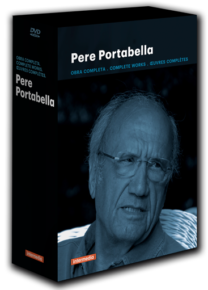 1. At last, Pere Portabella’s long-awaited and much-delayed Complete Works, beautifully and simply produced. It comes in a compact box from Intermedio: seven DVDs containing 22 films (six features and 16 shorts, at least if one film as long as 50 minutes counts as a short), from Don’t Count on Your Fingers (1967, 26 minutes) to the five-minute 2009 sing-along Uno de aquéllos (erroneously labelled as three minutes long on the box). Everything is outfitted with optional English, Castilian, and French subtitles, and the whole package is available for €74,99 plus postage from Spanish Amazon. The only “old-fashioned” particular on which Portabella hasn’t budged—a position he shares with David Lynch—is his decision not to include chapter divisions on any of his features, and that includes the nearly three-hour General Report, his remarkable 1977 talkfest about Spain shortly after the death of Franco. So if, for example, you want to access the much-delayed credit sequence in his mind-boggling Warsaw Bridge (1989), 23 minutes into that 85-minute feature, you’ll either have to fast-forward your way to it or else (horrors!) watch the whole feature straight through the way that Portabella intended you to watch it. But the look and sound of every film I’ve checked in this set is so wonderfully rendered that I can’t bring myself to complain. Just for starters, the unearthly, textured grain of the opening sequences of both Vampir-Cuadecuc and Umbracle (1972) has been perfectly captured.
1. At last, Pere Portabella’s long-awaited and much-delayed Complete Works, beautifully and simply produced. It comes in a compact box from Intermedio: seven DVDs containing 22 films (six features and 16 shorts, at least if one film as long as 50 minutes counts as a short), from Don’t Count on Your Fingers (1967, 26 minutes) to the five-minute 2009 sing-along Uno de aquéllos (erroneously labelled as three minutes long on the box). Everything is outfitted with optional English, Castilian, and French subtitles, and the whole package is available for €74,99 plus postage from Spanish Amazon. The only “old-fashioned” particular on which Portabella hasn’t budged—a position he shares with David Lynch—is his decision not to include chapter divisions on any of his features, and that includes the nearly three-hour General Report, his remarkable 1977 talkfest about Spain shortly after the death of Franco. So if, for example, you want to access the much-delayed credit sequence in his mind-boggling Warsaw Bridge (1989), 23 minutes into that 85-minute feature, you’ll either have to fast-forward your way to it or else (horrors!) watch the whole feature straight through the way that Portabella intended you to watch it. But the look and sound of every film I’ve checked in this set is so wonderfully rendered that I can’t bring myself to complain. Just for starters, the unearthly, textured grain of the opening sequences of both Vampir-Cuadecuc and Umbracle (1972) has been perfectly captured.
It would be presumptuous for me to call Portabella, now 84 years old, the greatest living Spanish (and Catalan) filmmaker, so let me just call him the greatest living Spanish (and Catalan) filmmaker that I’m familiar with. (For more specifics, go to my website, or my book Goodbye Cinema, Hello Cinephilia.) He is also plainly the most unknown of major Spanish filmmakers, at least outside of Spain, but this is basically because he distributes his own work and hasn’t felt the need to publicize it—and, more concretely, the only film of his ever to appear on a commercial DVD was his last commercial feature to date, The Silence Before Bach (2007), released only in Spain. Even as a diehard fan for the past 42 years, ever since I stumbled upon Vampir-Cuadecuc (still my favourite among his several masterpieces) in Cannes at the Director’s Fortnight, I still haven’t seen a number of his shorts, so this package is a treasure for me.
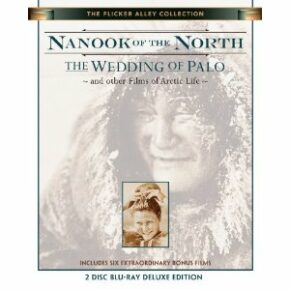 2. Both of the digital editions of Flaherty’s Nanook of the North (1922)—the earlier single-disc version from Criterion and the more recent two-disc Blu-ray from Flicker Alley (which also includes Knud Rasmussen’s 1934 The Wedding of Palos and other early film records of Arctic life, as well as Claude Massot’s 1988 Nanook Revisited)—are excellent, so which you opt for is partially a matter of how much you want or need. Both versions of the Flaherty masterpiece have the same excellent Timothy Brock score; the Flicker Alley Blu-ray is somewhat better visually, but Criterion’s eight-minute television interview with Flaherty’s widow Frances by Robert Gardner, not included in the Flicker Alley set, is moving and priceless.
2. Both of the digital editions of Flaherty’s Nanook of the North (1922)—the earlier single-disc version from Criterion and the more recent two-disc Blu-ray from Flicker Alley (which also includes Knud Rasmussen’s 1934 The Wedding of Palos and other early film records of Arctic life, as well as Claude Massot’s 1988 Nanook Revisited)—are excellent, so which you opt for is partially a matter of how much you want or need. Both versions of the Flaherty masterpiece have the same excellent Timothy Brock score; the Flicker Alley Blu-ray is somewhat better visually, but Criterion’s eight-minute television interview with Flaherty’s widow Frances by Robert Gardner, not included in the Flicker Alley set, is moving and priceless.
3. Whoever says that Alain Resnais’ films lack feeling—and this is a kind of libel that can even be traced back to certain alleged fans, such as the late Susan Sontag, as well as Resnais’ many dyed-in-the-wool American enemies—can’t be thinking of Hiroshima mon amour (1959) or Mélo (1986) or, for that matter, last year’s You Ain’t Seen Nothin’ Yet, and certainly not Providence (1977), perhaps the most deeply moving of all of Resnais’ films. It is also the one in which Resnais replies directly to this charge against him (behind the mask of David Mercer’s dialogue) with the just response that style is feeling. (I strongly suspect that the ironically apt employment of Frank Sinatra singing “It Was a Very Good Year” over the final credits of You Ain’t Seen Nothin’ Yet is no less personal, especially if one considers the opening line, “When I was 17…” While Resnais was 19 when his film’s foundational text, Jean Anouilh’s Eurydice, opened in Paris in late 1941, during the second year of the German Occupation, one can still see what he’s driving at.)
Yet Providence remains, to the best of my knowledge, the only Resnais feature that has never been released in a decent DVD version, although I’ve been hearing for years that a proper French release is forthcoming. The Spanish DVD has the unspeakable gall of including both the Spanish- and French-dubbed versions while leaving out the English-language original. (Resnais expert François Thomas has informed me that Resnais at least supervised the French dubbing, but that’s surely no excuse.) Meanwhile, various unauthorized copies have been turning up on the internet, and I suppose they’re better than nothing—though not sufficiently better to warrant any links from me for lazy web-cruisers. (Which is to say, go find your own lousy dub.)
Re-seeing one of those blotchy copies recently, I was struck most of all by how the film’s orphaned status is reflected in its form, its dramaturgy, its locations, and its casting. Though the central character is a novelist (John Gielgud, giving his greatest film performance), the dialogue relates far more to English theatre; indeed, this film practically initiates the preoccupation with theatre that dominates much of Resnais’ later work. And alongside the very fine performances by English actors—Gielgud, Dirk Bogarde, David Warner—are those by American actresses Ellen Burstyn and Elaine Stritch, while the film’s locations seem to oscillate between London and environs and Providence, R.I. and environs.
I’m sure plenty of dimwits have already turned such ambiguities into charges against the film, but for me this indeterminate in-betweenness is tied to the film’s raw and captivating power, especially as it confronts the very kind of distortions that dreams, memories, guilt feelings, and a novelistic imagination can produce. The profound beauty and mystery of the final “real” sequence in broad daylight, after the feature-length Joycean Nighttown sequence preceding it—which gives us apparently (but in fact deceptively) the same Clive Langham (Gielgud) alongside a radically different natural son (Bogarde) and bastard son (Warner) and a somewhat different daughter-in-law (Burstyn) than we have seen previously—testifies to the kind of emotional alchemy involved, which means that the “same” Langham turns out to be a crueller and even less reliable one than we have known so far. As a portrait of family dysfunction, the cumulative impact and address of the film calls to mind Long Day’s Journey into Night, and it’s hard to think of any higher praise. But when can we see this masterpiece properly? (P.S. Resnais’ 2009 Les herbes folles is available now on DVD from Sony Pictures Classics, and You Ain’t Seen Nothin’ Yet from StudioCanal in the UK.)
4. As long as we’re on the subject of overlooked surrealist movies that cry out for a decent (or, in this case, any) DVD edition, please allow me to cite the last feature of the underrated and fascinating Albert Lewin, The Living Idol (1957), an eccentric, delirious piece of Mayan mumbo-jumbo set in Mexico City that, according to what the late Carlos Clarens once told me, was the all-time favourite film of Henri Langlois. I can fully understand why Susan Felleman, in her excellent book on Lewin Botticelli in Hollywood, treats this as something less than a masterpiece: it’s a kind of Val Lewton hand-me-down (albeit in Eastman Color and CinemaScope), with Dana Andrews’ kid brother Steve Forrest as the lead, French ballerina Liliane Montevecchi (who also turns up in Fritz Lang’s Moonfleet [1955]) as the sacrificial heroine, and James Robertson Justice as the mad scientist/anthropologist. But having recently revisited the spectacular campus of the University of Mexico City, I have to insist that there’s something unbeatable from a surrealist standpoint about having a deadly jaguar stalk through it, as one does at the protracted climax here, however improbable or hokey the narrative pretexts might be for it.
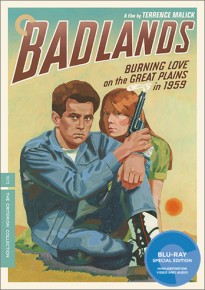 5. Badlands (Criterion Blu-ray). It’s probably unfashionable to say this, but Terrence Malick’s best film by far remains his 1973 debut. Why his best? I can think of a few reasons.
5. Badlands (Criterion Blu-ray). It’s probably unfashionable to say this, but Terrence Malick’s best film by far remains his 1973 debut. Why his best? I can think of a few reasons.
a) Badlands seems to be the only Malick film in which his Norman Rockwellian nostalgia and pie-eyed determination to remain innocent no matter what is met by a sense of genuine and mounting horror. Maybe this is nothing more than the inadvertent result of combining materials that don’t normally fit together, but they add up to something approaching a social commentary on a particular form of American dementia—or let’s say, at the very least, a certain social curiosity about it. No such curiosity seems to inform his subsequent work, at least to the point of giving it any kind of social edge. In this case, the romantic leads are clearly innocent monsters, while virtually all the major characters in Malick’s other films (and the writer-director-auteur himself—indeed, arguably him most of all), are clearly innocent but not so clearly monsters.
b) A surprising number of the most beautiful images in Malick’s subsequent work—the long shot of a passing train in Days of Heaven (1978), a cluster of American soldiers relaxing during off-time in The Thin Red Line (1998), a rush down an unpaved alley between two small-town domestic yards in The Tree of Life (2011)—are already present in Badlands, at least in embryo, along with a taste for Pop Art (evident in Warren Oates’ sign painting and a huge Pepsi-Cola sign hovering over Martin Sheen at a climactic juncture) that I don’t recall cropping up half as memorably elsewhere. More generally, the sheer weirdness and/or luminosity of some of the visual or audiovisual moments are especially plentiful here. To cite only a handful of these, culled from my 1974 review of the film for Monthly Film Bulletin: “Holly [Sissy Spacek] occupying a bed with an enormous dog”; “the integration of [her] greenish dress with the blue hallway in her house”; “the lyrical interlude (worthy of Fahrenheit 451) of fire consuming the house, ‘distanced’ by the use of silence and [Carl Orff and Gunild Keetman’s] ‘Musica Poetica’”; “the fairy-tale ambience and irony of the forest sojourn, Kit [Sheen] reading National Geographic while Holly muses pantheistically on the soundtrack”; “her attempt at small talk about a pet spider with a dying Cato [Ramon Bieri]”; “sepia newsreel-like glimpses of police and frightened townsfolk.”
c) Badlands has Malick’s best-written (and most literary as well as musically integrated) narration and dialogue, even after one allows for what he may have derived from James Jones in The Thin Red Line. Indeed, by the time one arrives at To the Wonder (which I prefer to call To the Wander), it’s difficult to describe the snippets of gush—aptly and hilariously described as such by James Quandt in the April 2013 Artforum—as any kind of writing at all, much as the scattershot editing often swerves us in the direction of a veritable compendium of calendar art and touristic postcards rather than any kind of coherent storytelling.
d) Badlands also offers what may be the only sign in Malick’s oeuvre of anything resembling a sense of humour. I suspect that this is part of what Michael Almereyda has in mind in his essay for Criterion, when he repeatedly links Kit with Flannery O’Connor’s Misfit in “A Good Man is Hard to Find”—a notion that may be a bit of a stretch, if only because O’Connor’s black comedy is far blacker, and ultimately far more serious.
On the other hand, if before my latest viewing of Badlands I’d seen the TV documentary about the bloody real-life 1958 exploits of Charles Starkweather and Caril Ann Fugate that Criterion includes as an extra—which is much creepier and far more ambiguous than Malick’s film, especially when it comes to Fugate’s involvement in the proceedings—I might have been turned off by some of these qualities. Malick’s complete avoidance of the grisly fact of Native American genocide in The New World (2005) is at least anticipated by the substantial clean-up job he does here, on a much more modest scale; in both cases, he’s frankly and unabashedly aiming at lyrical poetry and fairy tale, Pierrot le fou (1965) without the references to the war in Vietnam. Criterion should be thanked for helping us to glimpse the extensive dry-cleaning involved, although I wouldn’t expect any DVD label to offer us a corrective documentary about the mass slaughter of Indians to go with Malick’s virtual remake of the Disney Pocahontas (1995). After all, it would hardly be an exaggeration to claim that Americans are much more interested in mass murderers as holy figures than as creeps, especially if they’re supposed to resemble James Dean—a resemblance that Malick is eager to point out and amplify whenever and however it suits his obscure agenda.
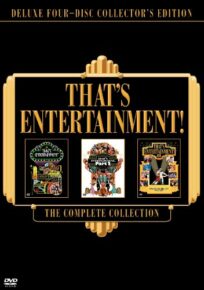 6. It beats me why Amazon lists That’s Entertainment! The Complete Collection without an exclamation point on Blu-ray (from $25.99) and with one on DVD (from $18.99), even though the package labelling on each appears to be the same. Either way, I’d call it a bargain, especially if one considers the plentiful extras included, despite the fact that the 1994 That’s Entertainment! III (the third disc on the Blu-ray) is the only truly exceptional feature in the bunch. While the first (1974) is perfunctory and the second (1976) borderline egregious, the third often qualifies as very enlightening film criticism and historiography concerning many of the blunders, misjudgments, and injustices carried out by MGM in their golden-age musicals.
6. It beats me why Amazon lists That’s Entertainment! The Complete Collection without an exclamation point on Blu-ray (from $25.99) and with one on DVD (from $18.99), even though the package labelling on each appears to be the same. Either way, I’d call it a bargain, especially if one considers the plentiful extras included, despite the fact that the 1994 That’s Entertainment! III (the third disc on the Blu-ray) is the only truly exceptional feature in the bunch. While the first (1974) is perfunctory and the second (1976) borderline egregious, the third often qualifies as very enlightening film criticism and historiography concerning many of the blunders, misjudgments, and injustices carried out by MGM in their golden-age musicals.
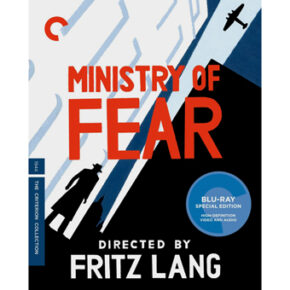 7. Ministry of Fear (Criterion Blu-ray). I have no recollection of having read Graham Greene’s novel, but it’s easy enough to understand why he despised Fritz Lang’s 1944 film adaptation given the sloppy, semi-coherent script cobbled together by associate producer Seton I. Miller (who had previously done creditable work for Howard Hawks, notably on the 1932 Scarface), which Lang was powerless to change. In some ways, however, Lang’s relative lack of leeway may have actually helped to make this film even more nightmarish in some of its moods and images (the “return of the repressed”)—a fact suggested by both Glenn Kenny’s essay and Bernard Eisenschitz’s helpful material on the film in his excellent and untranslated Fritz Lang au travail. The funny part is, I know I’d already seen this film more than once, but apart from recalling fragments of a scene or two, seeing this again on Blu-ray was almost like seeing it for the first time. After all, entertainments are supposed to be disposable, hence renewable and therefore repeatable.
7. Ministry of Fear (Criterion Blu-ray). I have no recollection of having read Graham Greene’s novel, but it’s easy enough to understand why he despised Fritz Lang’s 1944 film adaptation given the sloppy, semi-coherent script cobbled together by associate producer Seton I. Miller (who had previously done creditable work for Howard Hawks, notably on the 1932 Scarface), which Lang was powerless to change. In some ways, however, Lang’s relative lack of leeway may have actually helped to make this film even more nightmarish in some of its moods and images (the “return of the repressed”)—a fact suggested by both Glenn Kenny’s essay and Bernard Eisenschitz’s helpful material on the film in his excellent and untranslated Fritz Lang au travail. The funny part is, I know I’d already seen this film more than once, but apart from recalling fragments of a scene or two, seeing this again on Blu-ray was almost like seeing it for the first time. After all, entertainments are supposed to be disposable, hence renewable and therefore repeatable.
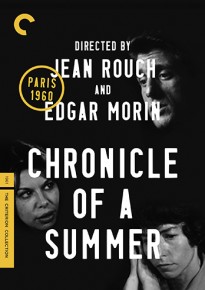 8. My favourite Criterion Blu-ray of the quarter has got to be Jean Rouch and Edgar Morin’s Chronicle of a Summer (Chronique d’un été, 1961), scandalously overlooked in the US upon its release and now available in an ideal edition. Criterion has packaged it with a superb feature-length 2011 documentary about the film—featuring outtakes as well as some new interviews and reconsiderations—directed by Florence Dauman (daughter of the film’s producer Anatole Dauman), as well as other thoughts, new and old, by Rouch, Marceline Loridan (one of the participants in the film), Faye Ginsburg, and Sam Di Iorio.
8. My favourite Criterion Blu-ray of the quarter has got to be Jean Rouch and Edgar Morin’s Chronicle of a Summer (Chronique d’un été, 1961), scandalously overlooked in the US upon its release and now available in an ideal edition. Criterion has packaged it with a superb feature-length 2011 documentary about the film—featuring outtakes as well as some new interviews and reconsiderations—directed by Florence Dauman (daughter of the film’s producer Anatole Dauman), as well as other thoughts, new and old, by Rouch, Marceline Loridan (one of the participants in the film), Faye Ginsburg, and Sam Di Iorio.
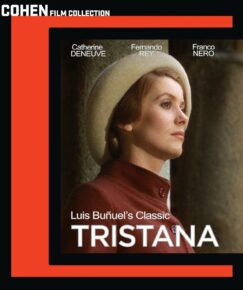 9. Dare I say it? When push comes to shove, Luis Buñuel’s first feature, the celebrated 63-minute L’âge d’or (1930), isn’t really all that good, especially if one compares it to Un chien Andalou (1929), which continues to seem inexhaustible in its beauty and mystery. (Both films are available in an excellent dual-format BFI edition, with many extras.) But very little in L’âge d’or is either beautiful or mysterious, and a good deal of it now seems insufferably glib and laboured, even conventionally unconventional in many of its ritualistic gestures to outrage the bourgeoisie. Jesus as the Marquis de Sade, emerging from a night of torturing and ravishing virgins with a beatific smile on his lips? Strictly third-grade stuff, both in concept and execution—and this is actually supposed to be the film’s grand climax. The other climactic sequence, by comparison, in which all that stuff gets thrown successively out of a window, at least has a certain dash and flair as a catalogue of Surrealist objects. But for prime Buñuel, let me suggest that you turn instead to Tristana (1970)—only his second Spanish feature, after the 1961 Viridiana (and arguably his last if one excludes That Obscure Object of Desire, a French-Spanish co-production of 1977), and a much quieter but arguably far more devastating assault on bourgeois complacency—which is out now in an excellent Blu-ray as the first release of the newly launched Cohen Film Collection.
9. Dare I say it? When push comes to shove, Luis Buñuel’s first feature, the celebrated 63-minute L’âge d’or (1930), isn’t really all that good, especially if one compares it to Un chien Andalou (1929), which continues to seem inexhaustible in its beauty and mystery. (Both films are available in an excellent dual-format BFI edition, with many extras.) But very little in L’âge d’or is either beautiful or mysterious, and a good deal of it now seems insufferably glib and laboured, even conventionally unconventional in many of its ritualistic gestures to outrage the bourgeoisie. Jesus as the Marquis de Sade, emerging from a night of torturing and ravishing virgins with a beatific smile on his lips? Strictly third-grade stuff, both in concept and execution—and this is actually supposed to be the film’s grand climax. The other climactic sequence, by comparison, in which all that stuff gets thrown successively out of a window, at least has a certain dash and flair as a catalogue of Surrealist objects. But for prime Buñuel, let me suggest that you turn instead to Tristana (1970)—only his second Spanish feature, after the 1961 Viridiana (and arguably his last if one excludes That Obscure Object of Desire, a French-Spanish co-production of 1977), and a much quieter but arguably far more devastating assault on bourgeois complacency—which is out now in an excellent Blu-ray as the first release of the newly launched Cohen Film Collection.
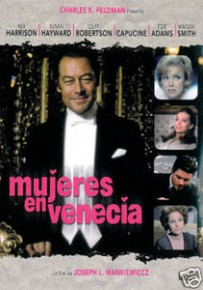 10. My recent first look at Cleopatra (1963) has led me to other late works of Joseph L. Mankiewicz: There Was a Crooked Man (1970), a cynical and somewhat glib western, scripted by Robert Benton and David Newman and reeking with ’60s attitude; and The Honey Pot (1967), a delightfully intricate riff on Volpone set in Venice, scripted by Mankiewicz and replaying a few of the better conceits from his 1950 All About Eve (including more than a few hidden, slow-to-surface bitter almonds). Both of these items are overpriced on North American Amazon, so you might want to consider getting the latter from Spanish Amazon, under the title Mujeres en Venecia. (It was one of the favourite films listed by the late, great critic Frieda Grafe, who also included Wilder’s comparably great and neglected 1972 Avanti! on the same list, leading me to reflect on the abiding appeal of Italian settings for German critics.)
10. My recent first look at Cleopatra (1963) has led me to other late works of Joseph L. Mankiewicz: There Was a Crooked Man (1970), a cynical and somewhat glib western, scripted by Robert Benton and David Newman and reeking with ’60s attitude; and The Honey Pot (1967), a delightfully intricate riff on Volpone set in Venice, scripted by Mankiewicz and replaying a few of the better conceits from his 1950 All About Eve (including more than a few hidden, slow-to-surface bitter almonds). Both of these items are overpriced on North American Amazon, so you might want to consider getting the latter from Spanish Amazon, under the title Mujeres en Venecia. (It was one of the favourite films listed by the late, great critic Frieda Grafe, who also included Wilder’s comparably great and neglected 1972 Avanti! on the same list, leading me to reflect on the abiding appeal of Italian settings for German critics.)
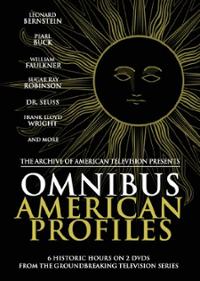 11. Two priceless history lessons: a pair of two-disc DVD collections from the Archive of American Television, both drawn from the famous highbrow Sunday show of 1952-1961, Omnibus. (In the same series, you can get Peter Brook’s 1953 TV production of King Lear with Orson Welles on a single disc, and seven Leonard Bernstein specials from 1954-58, on four discs.) One of the sets is devoted to the condensed 1955 version of James Agee’s remarkable five-part mini-series Mr. Lincoln and the Civil War (1952-53), fleshed out with a 16-minute discussion by Agee and Allan Nevins in 1953 about Lincoln and Ann Rutledge, and various other TV items from the same period relating to the Civil War. But the gem is on the second set, Omnibus: American Profiles: an 18-minute feature about William Faulkner, filmed in Oxford, Mississippi, and broadcast on December 28, 1952. It’s hard to know which is more precious here: the filmed record of Faulkner himself (seemingly occasioned by his Nobel Prize two years earlier), or the outlandish amount of playacting required from him and various local friends and acquaintances who were asked to pretend that they were all having spontaneous chats around town, such as when his journalist chum “Moon” Mullin is seen driving to the Faulkner mansion for one such encounter, followed by a cut to Faulkner inside the house coming to the door. (This blatant contrivance recalls the pseudo-documentary footage in Leo McCarey’s My Son John, released the same year, in which we cut from Helen Hayes’ character using her son’s key to enter his secret Commie love nest to a shot inside the “empty” flat that she’s entering.)
11. Two priceless history lessons: a pair of two-disc DVD collections from the Archive of American Television, both drawn from the famous highbrow Sunday show of 1952-1961, Omnibus. (In the same series, you can get Peter Brook’s 1953 TV production of King Lear with Orson Welles on a single disc, and seven Leonard Bernstein specials from 1954-58, on four discs.) One of the sets is devoted to the condensed 1955 version of James Agee’s remarkable five-part mini-series Mr. Lincoln and the Civil War (1952-53), fleshed out with a 16-minute discussion by Agee and Allan Nevins in 1953 about Lincoln and Ann Rutledge, and various other TV items from the same period relating to the Civil War. But the gem is on the second set, Omnibus: American Profiles: an 18-minute feature about William Faulkner, filmed in Oxford, Mississippi, and broadcast on December 28, 1952. It’s hard to know which is more precious here: the filmed record of Faulkner himself (seemingly occasioned by his Nobel Prize two years earlier), or the outlandish amount of playacting required from him and various local friends and acquaintances who were asked to pretend that they were all having spontaneous chats around town, such as when his journalist chum “Moon” Mullin is seen driving to the Faulkner mansion for one such encounter, followed by a cut to Faulkner inside the house coming to the door. (This blatant contrivance recalls the pseudo-documentary footage in Leo McCarey’s My Son John, released the same year, in which we cut from Helen Hayes’ character using her son’s key to enter his secret Commie love nest to a shot inside the “empty” flat that she’s entering.)
It’s fascinating to assume that viewers back in 1952 were all that innocent about documentary film technique, but we shouldn’t conclude from this that we’re necessarily much smarter today. (Would the same folks in 1952 have bought into the same government lies used to justify the invasion of Iraq a half-century later? Maybe so, but maybe not.) It’s touching, in any case, to see and hear Faulkner awkwardly explaining his desire not to be photographed to one of his pals—which reminds me of a preposterous photo spread that I saw as a teenager in Photoplay a few years later, chronicling what was avowedly the first date Fabian was able to have without any photographers coming along…
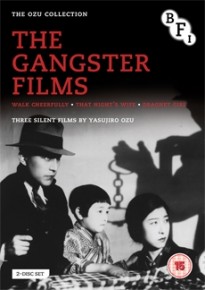 12. The Gangster Films: Three Silent Films by Yasujiro Ozu (BFI). This two-disc DVD set includes Walk Cheerfully (1930), the uncharacteristic and fascinating That Night’s Wife (1930, the most Sternbergian and claustrophobic of Ozu’s surviving silent pictures), and Dragnet Girl (1933), along with the surviving 13-minute fragment of the 1929 A Straightforward Boy (which was originally about three times as long) and a ten-minute excerpt from a Tony Rayns lecture about Ozu as extras.
12. The Gangster Films: Three Silent Films by Yasujiro Ozu (BFI). This two-disc DVD set includes Walk Cheerfully (1930), the uncharacteristic and fascinating That Night’s Wife (1930, the most Sternbergian and claustrophobic of Ozu’s surviving silent pictures), and Dragnet Girl (1933), along with the surviving 13-minute fragment of the 1929 A Straightforward Boy (which was originally about three times as long) and a ten-minute excerpt from a Tony Rayns lecture about Ozu as extras.
A Straightforward Boy, incidentally, is inspired by “The Ransom of Red Chief”—a comic tale by O. Henry about the kidnapping of a little boy who’s so aggressive that the kidnappers eventually have to pay his parents in order to get rid of him, which was adapted years later by Howard Hawks in O. Henry’s Full House (1952)—and the title brat, Tomio Aoki, made such a hit in the part (launching a career that lasted over 70 years) that he changed his name to the film’s Japanese title, Tokkan Kozo, and became a regular fixture in Ozu’s work; he’s especially memorable in Passing Fancy (1933) and as the younger brother in I Was Born, But… (1932). The high point of my first visit to Japan, in 1999, came at the end of a panel devoted to Ozu when an elderly gentleman approached Hou Hsiao-hsien and myself (both of us panelists) in the lobby, shook both our hands, said something in Japanese, and then walked away. Hou, to his credit, immediately recognized him as Tomio Aoki/Tokkan Kozo, which he signalled to me by imitating one of the kid’s signature gestures in I Was Born, But…
13. Extremely pleasurable (for me, anyway): Pip Chodorov’s Free Radicals: A History of Experimental Film (2011), from Kino Lorber and Chodorov’s own label, Re:Voir. It’s amazing how much he’s able to pack in without rushing or overstuffing, and the interviews—with everyone from Chodorov’s own father to Hans Richter, Robert Breer, Brakhage, Jacobs, Kubelka, Lemaître, Lye, Mekas, and Snow, among others—are very lively (though I wish he’d made some more room for women).
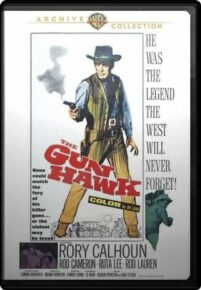 Moderately pleasurable: Edward Ludwig’s The Gun Hawk, from the Warners Archive Collection, at least for its weird dysfunctional-family homoeroticism. I wound up watching this because it made Godard’s ten-best list of 1963; he even gives a verbal nod to Ludwig in his underrated Made in USA (1966), a film I was happy to rewatch recently in its erudite Criterion edition. I’m only sorry that the insightful commentators who contribute to the disc haven’t paid more attention to Godard’s love/hatred for American culture here (especially cartoons and male-bonding action movies) as expressed specifically through sound and image, just as his film’s opening dedication to Nick (Ray) and Sam (Fuller) implies.
Moderately pleasurable: Edward Ludwig’s The Gun Hawk, from the Warners Archive Collection, at least for its weird dysfunctional-family homoeroticism. I wound up watching this because it made Godard’s ten-best list of 1963; he even gives a verbal nod to Ludwig in his underrated Made in USA (1966), a film I was happy to rewatch recently in its erudite Criterion edition. I’m only sorry that the insightful commentators who contribute to the disc haven’t paid more attention to Godard’s love/hatred for American culture here (especially cartoons and male-bonding action movies) as expressed specifically through sound and image, just as his film’s opening dedication to Nick (Ray) and Sam (Fuller) implies.
Not at all pleasurable (though believe me, I tried): Brian De Palma’s The Fury (1978), from the sleek schlock specialists at Twilight Time. Maybe Pauline Kael’s nihilist/camp manifesto on behalf of this mess made it even less tolerable to me; after rightly faulting the script, structure, dialogue, pacing, and even, if I understood her correctly, the meaning (or lack of same), she still had to insist that “No Hitchcock thriller was ever so intense, went so far, or had so many ‘classic’ sequences,” and “One can imagine Welles, Peckinpah, Scorsese, and Spielberg still stunned, bowing to the ground, choking with laughter.” How could she have left out Eisenstein, Leone, Friedkin, and Tex Avery? Personally, I can only imagine Tarantino or von Trier, Kael’s wicked stepchildren, responding in such a fashion to Brian’s brio. For poetic silliness, give me The Living Idol any day.
 14. Two very basic Blu-rays recently released by Criterion are in effect, or at least partially, upgrades of previously available DVDs on other labels. But the two-disc edition of A Man Escaped (1956)—my favourite Robert Bresson film, which was already available with English subtitles on a French DVD—gives us many invaluable extras, including a complete and fully subtitled version of Robert Bresson: Without a Trace, François Weyergans’ excellent feature-length documentary about Bresson done for the great French TV series Cinéastes de notre temps in 1965; a new audiovisual essay in which David Bordwell and Kristin Thompson analyze the film’s use of sound; a new print essay by Tony Pipolo; and much, much more. Criterion’s single-disc Monsieur Verdoux adds to the already available and excellent 2003 documentary by Bernard Eisenschitz (with sharp contributions by Claude Chabrol) a provocative new print essay by Ignatiy Vishnevetsky, along with recycled material from André Bazin and Chaplin, a fascinating illustrated audio interview with actress Marilyn Nash, and a so-so new documentary called Charlie Chaplin and the American Press.
14. Two very basic Blu-rays recently released by Criterion are in effect, or at least partially, upgrades of previously available DVDs on other labels. But the two-disc edition of A Man Escaped (1956)—my favourite Robert Bresson film, which was already available with English subtitles on a French DVD—gives us many invaluable extras, including a complete and fully subtitled version of Robert Bresson: Without a Trace, François Weyergans’ excellent feature-length documentary about Bresson done for the great French TV series Cinéastes de notre temps in 1965; a new audiovisual essay in which David Bordwell and Kristin Thompson analyze the film’s use of sound; a new print essay by Tony Pipolo; and much, much more. Criterion’s single-disc Monsieur Verdoux adds to the already available and excellent 2003 documentary by Bernard Eisenschitz (with sharp contributions by Claude Chabrol) a provocative new print essay by Ignatiy Vishnevetsky, along with recycled material from André Bazin and Chaplin, a fascinating illustrated audio interview with actress Marilyn Nash, and a so-so new documentary called Charlie Chaplin and the American Press.
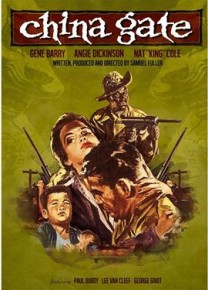 15. A Blu-ray of Samuel Fuller’s splendid if crazy China Gate (1957). Manny Farber wrote in 1969 that the film is “so absurd that it becomes an enchantment to the camp taste,” after pointing out that it “is sincere about inexplicable mush.” Fuller himself wrote a quarter of a century later, “With its highly stylized characters, China Gate may seem like a cartoon today,” and I suppose all three of these assertions have some measure of truth. But Farber missed the boat completely when he accused Fuller of condescending racism and mused over Nat “King” Cole’s “type of demented happiness at being part of the white man’s insane projects” in the same sentence—clearly not getting that Cole’s mercenary in Indo-China, a former member of the Big Red One who laments not having a kid and despises the racist hero for both his racism and his dereliction as a father, is clearly the character in the movie Fuller most identifies with. In fact, both of Fuller’s black-and-white CinemaScope movies (this one and Forty Guns [1957], made back to back at Fox) are over-the-top concoctions whose raw emotions are never less than real—a confusing combo, but Fuller’s movies are never half as easy to swallow as Farber seemed to think they should be (or apparently wanted them to be). According to him, “the craziness of these propagandist films is that the white hero is such trash: unprincipled, stupid, loud-mouthed, mean, thinking nothing about mauling women or any man a foot shorter,” as if Fuller was unaware of and/or approving of such traits. Once again, you might say that Farber has a point, but only if you substitute “sanity” for “craziness” and then put “highly conflicted” just before “propagandist.”
15. A Blu-ray of Samuel Fuller’s splendid if crazy China Gate (1957). Manny Farber wrote in 1969 that the film is “so absurd that it becomes an enchantment to the camp taste,” after pointing out that it “is sincere about inexplicable mush.” Fuller himself wrote a quarter of a century later, “With its highly stylized characters, China Gate may seem like a cartoon today,” and I suppose all three of these assertions have some measure of truth. But Farber missed the boat completely when he accused Fuller of condescending racism and mused over Nat “King” Cole’s “type of demented happiness at being part of the white man’s insane projects” in the same sentence—clearly not getting that Cole’s mercenary in Indo-China, a former member of the Big Red One who laments not having a kid and despises the racist hero for both his racism and his dereliction as a father, is clearly the character in the movie Fuller most identifies with. In fact, both of Fuller’s black-and-white CinemaScope movies (this one and Forty Guns [1957], made back to back at Fox) are over-the-top concoctions whose raw emotions are never less than real—a confusing combo, but Fuller’s movies are never half as easy to swallow as Farber seemed to think they should be (or apparently wanted them to be). According to him, “the craziness of these propagandist films is that the white hero is such trash: unprincipled, stupid, loud-mouthed, mean, thinking nothing about mauling women or any man a foot shorter,” as if Fuller was unaware of and/or approving of such traits. Once again, you might say that Farber has a point, but only if you substitute “sanity” for “craziness” and then put “highly conflicted” just before “propagandist.”
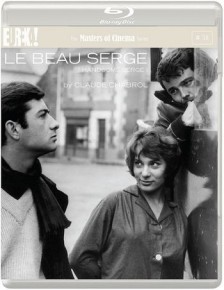 16. Two Blu-rays from Masters of Cinema: Claude Chabrol’s Le beau Serge (1958) and Les cousins (1959). When it comes to early Chabrol, I must admit I prefer À double tour (1959), Les bonnes femmes (1960), and even the overlooked Les godelureaux (1961) and Ophélia (1963). But these earlier two features come with handsome and useful booklets, plus the two earliest Chabrol shorts—L’avarice from The Seven Deadly Sins (1961) with Le beau Serge, The Man Who Sold the Eiffel Tower from The World’s Most Beautiful Frauds (1964) with Les cousins—and an hour-long “making-of” documentary with each feature. Both shorts are in black-and-white ’Scope (the first times Chabrol shot in that format), and the first is immensely better than the second, visually and otherwise. The latter, which I’d never seen before, is a stridently unfunny comedy about a German rube who gets “sold” the Eiffel Tower as if it were the Brooklyn Bridge; the only spot of passing interest here is Catherine Deneuve as the main swindler’s bimbo squeeze, the very same year that she starred in Les parapluies de Cherbourg, typically seen here knitting in the backgrounds of a few shots.
16. Two Blu-rays from Masters of Cinema: Claude Chabrol’s Le beau Serge (1958) and Les cousins (1959). When it comes to early Chabrol, I must admit I prefer À double tour (1959), Les bonnes femmes (1960), and even the overlooked Les godelureaux (1961) and Ophélia (1963). But these earlier two features come with handsome and useful booklets, plus the two earliest Chabrol shorts—L’avarice from The Seven Deadly Sins (1961) with Le beau Serge, The Man Who Sold the Eiffel Tower from The World’s Most Beautiful Frauds (1964) with Les cousins—and an hour-long “making-of” documentary with each feature. Both shorts are in black-and-white ’Scope (the first times Chabrol shot in that format), and the first is immensely better than the second, visually and otherwise. The latter, which I’d never seen before, is a stridently unfunny comedy about a German rube who gets “sold” the Eiffel Tower as if it were the Brooklyn Bridge; the only spot of passing interest here is Catherine Deneuve as the main swindler’s bimbo squeeze, the very same year that she starred in Les parapluies de Cherbourg, typically seen here knitting in the backgrounds of a few shots.
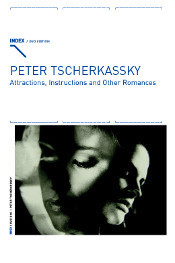 17. Peter Tscherkassky: Attractions, Instructions and Other Romances. A welcome second PAL, region-free DVD of Tscherkassky’s experimental shorts from Index (www.index-dvd.at/en/program/040/index.html) after Films from a Dark Room, which includes his better-known 35mm black-and-white ’Scope extravaganzas L’Arrivée (1998), Outer Space (1999), and Dream Work (2001), and which I noted in my Spring 2006 column. Each of these essential collections features recent work as well as earlier work done back in the 1980s, and come with helpful, bilingual 20-page booklets.
17. Peter Tscherkassky: Attractions, Instructions and Other Romances. A welcome second PAL, region-free DVD of Tscherkassky’s experimental shorts from Index (www.index-dvd.at/en/program/040/index.html) after Films from a Dark Room, which includes his better-known 35mm black-and-white ’Scope extravaganzas L’Arrivée (1998), Outer Space (1999), and Dream Work (2001), and which I noted in my Spring 2006 column. Each of these essential collections features recent work as well as earlier work done back in the 1980s, and come with helpful, bilingual 20-page booklets.
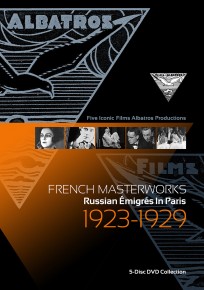 18. At the beginning of this quarter, the arrival of Marcel L’Herbier’s The Late Mathias Pascal (1926) from Flicker Alley prompted me to append to my 1976 review of this film for Monthly Film Bulletin the following, on my website: “A tinted restoration of this film was presented at Bologna’s Il Cinema Ritrovato with a beautiful, large-orchestra score composed and conducted by Timothy Brock a few years back, and I must say that this very impressive presentation substantially transformed my original skepticism, fully demonstrating how much difference a serious archival restoration can make. And now Flicker Alley has just brought out this version on a lovely Blu-ray, which I can heartily recommend.” But now, before I can think of anything to add to this, and just as this column is going to press, Flicker Alley sends me a five-disc DVD box set devoted to Alexander Kamenka’s Films Albatros, French Masterworks: Russian Émigrés in Paris, 1923-1928, including the L’Herbier feature and four others, two of which also feature the talents of Mathias Pascal star Ivan Mosjoukine: Le brasier ardent (The Burning Crucible, 1923) which Mosjoukine directed and in which he plays no less than 11 roles, and Alexandre Volkoff’s Kean (1923), with Mosjoukine collaborating on the script and playing the title role. Rounding out this collection are two Jacques Feyder features, Gribiche (1926) and Les nouveaux messieurs (The New Gentlemen, 1928).
18. At the beginning of this quarter, the arrival of Marcel L’Herbier’s The Late Mathias Pascal (1926) from Flicker Alley prompted me to append to my 1976 review of this film for Monthly Film Bulletin the following, on my website: “A tinted restoration of this film was presented at Bologna’s Il Cinema Ritrovato with a beautiful, large-orchestra score composed and conducted by Timothy Brock a few years back, and I must say that this very impressive presentation substantially transformed my original skepticism, fully demonstrating how much difference a serious archival restoration can make. And now Flicker Alley has just brought out this version on a lovely Blu-ray, which I can heartily recommend.” But now, before I can think of anything to add to this, and just as this column is going to press, Flicker Alley sends me a five-disc DVD box set devoted to Alexander Kamenka’s Films Albatros, French Masterworks: Russian Émigrés in Paris, 1923-1928, including the L’Herbier feature and four others, two of which also feature the talents of Mathias Pascal star Ivan Mosjoukine: Le brasier ardent (The Burning Crucible, 1923) which Mosjoukine directed and in which he plays no less than 11 roles, and Alexandre Volkoff’s Kean (1923), with Mosjoukine collaborating on the script and playing the title role. Rounding out this collection are two Jacques Feyder features, Gribiche (1926) and Les nouveaux messieurs (The New Gentlemen, 1928).
- « Previous
- 1
- 2


